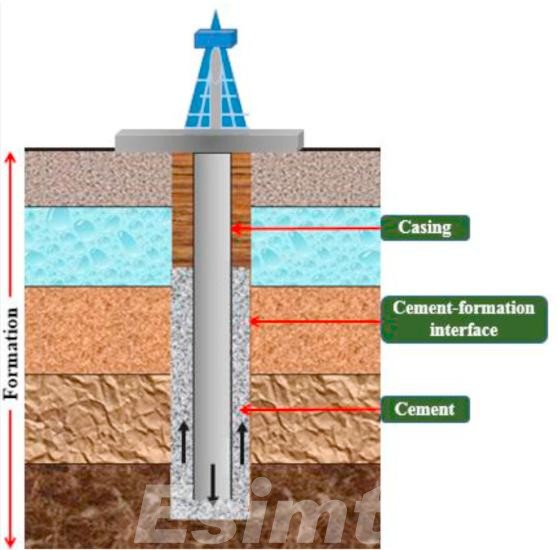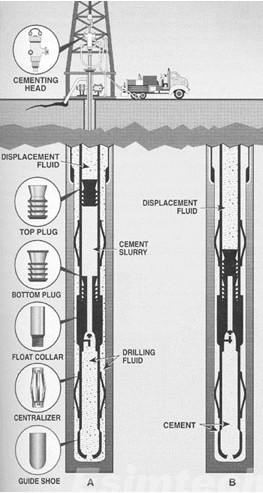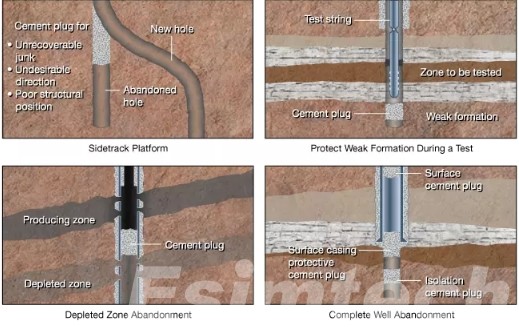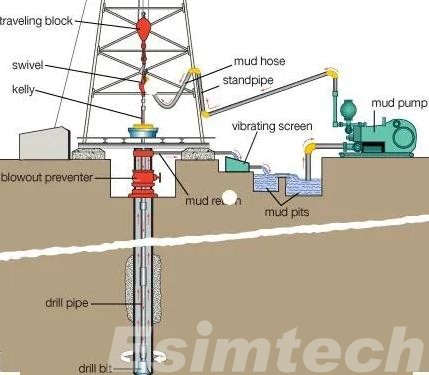How Much Do You Know about Plug Cementing
Plug cementing is a crucial technique in the oil and gas industry. It is used for sealing and securing wellbore sections to ensure the safety and integrity of a well. With its ability to prevent unwanted fluid migration, protect reservoirs, and mitigate environmental risks, plug cementing plays a pivotal role in drilling operations and well lifecycle management.

What is Plug Cementing
Plug cementing involves the placement of a cement plug in the wellbore to create a barrier. The cement mixture is typically pumped through the wellbore to form a solid plug at a predetermined depth. Once the cement sets, it acts as a permanent barrier, blocking the flow of fluids and gases and ensuring well integrity. This process is utilized during various stages of well operations, including during drilling, production, maintenance and well abandonment.

Applications of Plug Cementing in the Oil and Gas Industry
- Wellbore Isolation: During drilling, it’s often necessary to isolate certain zones within the wellbore to prevent fluid migration. A cement plug can be set to separate different formations, ensuring the integrity of the wellbore while minimizing contamination and pressure imbalances.
- Well Abandonment: In the decommissioning phase of a well’s life, plug cementing is used to permanently seal the well and prevent any potential leaks of hydrocarbons or formation fluids into the environment. This step is crucial in reducing long-term environmental risks associated with abandoned wells.
- Sidetracking: In situations where drilling needs to deviate from the original well path, a cement plug is placed in the wellbore to create a solid base from which a new borehole can be drilled in a different direction. This process, known as sidetracking, is a cost-effective way to continue drilling without abandoning the well entirely.
- Repairing Damaged Wells: Cement plugs can be used to repair well integrity issues, such as casing leaks, by sealing off the damaged section of the well and restoring its functionality. This is especially important in aging wells where corrosion or other mechanical failures compromise performance.
- Zonal Isolation: Plug cementing is used for separating specific zones in a well, allowing operators to target different production zones independently. It is particularly effective in enhancing well control and optimizing production from multiple reservoirs within a single well.

Main Types of Plug Cementing
1. Balanced Plug Cementing
Balanced plug cementing is the most commonly used method. It involves pumping cement slurry into the wellbore with careful attention to balancing the pressures on both sides of the cement plug. The process ensures that the cement stays in place at the desired depth and solidifies to form a reliable barrier.
- Application: Suitable for placing plugs at various depths in the wellbore.
- Advantages: Simple and widely applicable; can be used in vertical, inclined, or horizontal wells.
- Challenges: Requires precise balancing of fluid volumes and densities to avoid slurry displacement.
2. Dump Bailer Plug Cementing
This method uses a dump bailer, a tool lowered into the wellbore to deposit small amounts of cement slurry at specific depths. It’s often employed when cementing in small sections or where it’s impractical to use full rig equipment.
Application: Commonly used for shallow wells or during workover operations.
Advantages: Simple and cost-effective for small-scale operations.
Challenges: Limited to smaller volumes of cement, making it unsuitable for deep or high-pressure wells.
3. Cement Retainer Method
A cement retainer tool is placed at the desired location in the wellbore to act as a barrier, preventing cement from flowing beyond a certain point. Cement is then pumped above the retainer to create the plug.
- Application: Ideal for high-pressure wells or situations where precise plug placement is essential.
- Advantages: Provides better control over plug placement and prevents cement slurry from flowing into unwanted zones.
- Challenges: Requires additional equipment (cement retainer) and is more complex than other methods.
4. Two-Plug Cementing System
This technique involves using two plugs — a bottom plug and a top plug — to ensure that the cement slurry is properly displaced. The bottom plug is pumped ahead of the cement to separate it from the drilling fluids, while the top plug follows to push the cement into place.
- Application: Used in casing cementing and where separation of fluids is critical.
- Advantages: Ensures clean separation of fluids and accurate placement of the cement.
- Challenges: More time-consuming and requires careful monitoring to avoid plug misplacement.
5. Bradenhead Cementing
In this method, cement is pumped down the casing and allowed to flow back to the surface between the casing and the wellbore. It’s typically used in situations where surface isolation or shallow cementing is needed.
- Application: Commonly used for shallow wells or to isolate the surface casing.
- Advantages: Simple and effective for shallow operations.
- Challenges: Limited to shallower depths; not effective for deep well operations.
6. Squeeze Cementing
Squeeze cementing involves pumping cement into a well under pressure to force it into small fractures, voids, or perforations in the casing or wellbore. This method is used to repair wellbore integrity or seal off unwanted zones.
- Application: Ideal for repairing casing leaks or isolating specific zones within the wellbore.
- Advantages: Highly effective for well repairs and zonal isolation.
- Challenges: Requires precise control of pressure to avoid damaging the wellbore.
7. Packer-Assisted Cementing
A packer is used to isolate the section of the well where cementing is needed. The packer seals off the wellbore, allowing cement to be pumped into a specific zone without interference from other fluids in the well.
- Application: Used for isolating sections of the well during cementing operations.
- Advantages: Ensures precise cement placement and prevents contamination from other wellbore fluids.
- Challenges: Requires specialized packer equipment and may increase operational complexity.
Challenges in Plug Cementing
This chart highlights the various challenges faced during plug cementing operations and their potential impacts on the success of the process.
| Challenge | Description | Impact |
| Zonal Isolation Failure | Poor bonding between cement and wellbore, allowing fluid migration between zones. | Leads to compromised well integrity, risk of contamination, and possible blowouts. |
| Gas Migration | Gas infiltrating the cement before it hardens, causing channels or weak points. | Weakens the cement plug, increasing the risk of leaks and loss of well control. |
| Fluid Contamination | Drilling or formation fluids mixing with the cement slurry, degrading its quality. | Reduces cement strength, leading to potential failure of the plug and need for remedial work. |
| Cement Placement Challenges | Difficulty in placing cement precisely at the target depth, especially in complex wells. | Results in incomplete isolation, requiring additional operations and increasing costs. |
| High-Pressure/High-Temperature (HPHT) Conditions | High-pressure, high-temperature environments that can affect cement integrity. | Causes cement cracking, shrinking, or degrading, reducing long-term plug effectiveness. |
| Uncontrolled Cement Setting Time | Improper control over the cement setting time, causing premature or delayed hardening. | Leads to displacement issues, plug instability, and potential failure in sealing off zones. |
| Wellbore Instability | Collapse or deformation of the wellbore during cementing due to unstable formations. | Can result in incomplete cementing and plug failure, requiring further intervention. |
| Complex Well Geometries | Irregular or deviated well paths complicate the placement and solidification of cement plugs. | Increases the likelihood of incomplete cementing and reduces zonal isolation efficiency. |
| Cement Shrinkage | Cement volume reducing as it hardens, creating micro-annuli or gaps between casing and cement. | Opens potential leak paths and reduces the plug’s ability to isolate formations effectively. |
| Equipment Failures | Malfunctions in cementing tools, packers, or pumps during operations. | Delays cementing jobs, increasing operational costs and risks of plug misplacement or failure. |
| Temperature Variations | Fluctuations in downhole temperature affecting cement curing and bond strength. | Causes inconsistent setting and reduced plug strength, leading to long-term well integrity issues. |
| Limited Access in Older Wells | Difficulties accessing the desired plug depth in older or highly deviated wells. | Complicates cement placement and increases the risk of failure, leading to the need for advanced techniques. |
| Formation Reactions | Unpredictable responses from the formation, such as fluid influx or fractures opening during cementing. | Results in incomplete or failed plugs, requiring additional cementing attempts or remedial operations. |
| Environmental Regulations | Strict compliance requirements for cement composition and waste management. | Increases complexity and costs, pushing for innovation in materials while limiting certain practices. |

Key Advancements in Plug Cementing Technology
With growing complexity in drilling operations, deepwater exploration, and stricter environmental regulations, recent advancements in plug cementing technology have been pivotal in enhancing the reliability, precision, and efficiency of the process. These innovations are critical for ensuring well integrity, reducing operational risks, and extending the lifecycle of wells.
1. Advanced Cement Slurries
One of the most significant advancements in plug cementing has been the development of highly specialized cement slurries. These slurries are designed with additives that improve their performance in various well conditions, including extreme temperatures, high pressures, and corrosive environments.
- Low-Density Cement: Used to reduce the risk of fracturing weak formations during plug placement.
- Self-Healing Cement: Incorporates reactive materials that expand or heal when exposed to hydrocarbons, providing long-term integrity even in challenging conditions.
- High-Temperature/High-Pressure Cement: Formulated to withstand extreme downhole conditions without compromising the integrity of the plug.
These advanced slurries are tailored for specific well requirements, ensuring improved bond strength, durability, and resistance to gas migration and fluid intrusion.
2. Automated Cementing Systems
Automation is transforming plug cementing by enhancing the accuracy, consistency, and efficiency of cement placement. Automated cementing systems use real-time data and advanced sensors to control and monitor the cementing process.
- Real-Time Monitoring: Sensors monitor pressure, temperature, and slurry flow rates, ensuring optimal cement placement and reducing human error.
- Automated Mixing and Pumping: These systems precisely mix and pump cement slurry, improving the consistency and quality of the cement plug.
- Data-Driven Decisions: Advanced software and analytics allow operators to make real-time adjustments, ensuring the cement plug is placed accurately at the desired depth.
This level of automation not only improves the quality of the cementing job but also reduces downtime and enhances operational safety.
3. Smart Cement Technology
Smart cement is an innovative advancement that integrates sensors into the cement slurry. Once the cement plug is set, these sensors provide continuous data on the well’s condition, enabling operators to monitor the integrity of the plug over time.
- Embedded Sensors: Micro-electromechanical systems (MEMS) or fiber optic sensors are mixed into the slurry to track pressure, temperature, and cement bond integrity.
- Real-Time Data Transmission: These sensors transmit real-time data to surface equipment, allowing for continuous monitoring of the plug’s performance.
- Long-Term Integrity Monitoring: Smart cement technology provides early warnings of potential issues such as pressure build-up, temperature changes, or plug degradation, allowing operators to intervene before a failure occurs.
This technology is particularly beneficial for high-risk wells, such as deepwater or high-pressure/high-temperature (HPHT) wells, where continuous well integrity is crucial.
4. Nano-Enhanced Cementing Materials
Nanotechnology has made its way into cementing operations, with nano-enhanced materials being used to improve the mechanical properties of cement. Nano-additives, such as silica or alumina nanoparticles, are introduced into the cement slurry to enhance its strength, elasticity, and bonding properties.
- Improved Bond Strength: Nano-materials increase the bond strength between the cement and the wellbore or casing, minimizing the risk of gas migration and fluid movement.
- Enhanced Durability: These materials help the cement withstand extreme conditions, such as high temperatures and pressures, making it more durable over time.
- Faster Setting Times: Nanoparticles can also reduce the setting time of cement, allowing for quicker operations and reducing the risk of slurry contamination.
Nano-enhanced cementing materials are particularly useful in challenging environments where conventional cement might degrade over time.
5. Cementing Retainers with Better Pressure Control
Recent advancements in cementing retainers allow for improved control over pressure during cement placement. These devices are used to isolate certain sections of the well and ensure that cement is placed accurately without the risk of fluid migration or pressure loss.
- Improved Sealing Capabilities: New-generation retainers provide better seals and control in high-pressure wells, ensuring that the cement plug stays in place.
- Pressure Control Valves: Advanced retainers are equipped with pressure control valves that allow operators to manage pressure in real time during the cementing process.
- Multi-Stage Cementing: Retainers are now capable of facilitating multi-stage cementing, allowing for precise placement of cement plugs in different zones of the wellbore.
These advancements provide greater flexibility in complex wells, such as those with multiple reservoirs or highly deviated boreholes.
6. Innovative Cement Plug Placement Techniques
In addition to improvements in cement materials and equipment, there have been significant advancements in how cement plugs are placed in the wellbore. These new techniques improve placement accuracy, reduce waste, and ensure the longevity of the cement plug.
- Casing Drilling with Cement Plug Placement: This technique combines casing drilling with cementing, allowing operators to set a cement plug directly while drilling operations are ongoing. It improves well integrity while minimizing downtime.
- Expandable Cement Systems: Expandable cement systems allow the cement plug to expand after setting, providing a tighter seal against the wellbore and casing. This is particularly useful in high-pressure wells or wells with irregular wellbore shapes.
These innovative techniques help operators place cement plugs more efficiently while ensuring better long-term performance.
7. Digital Twin Technology for Plug Cementing
The introduction of digital twin technology has revolutionized the way plug cementing operations are planned and executed. A digital twin is a virtual model of the wellbore and cementing operations, allowing for oil and gas operation process simulations and real-time monitoring.
- Pre-Job Simulation: Engineers can simulate the plug cementing process before it happens, optimizing cement slurry volume, placement techniques, and equipment use.
- Real-Time Monitoring: Digital twins allow for real-time tracking of cementing operations, giving operators insights into pressure, slurry flow, and wellbore conditions.
- Predictive Maintenance: Digital twins can predict potential failures or issues during plug cementing, enabling operators to address them before they occur.

This technology improves the accuracy and efficiency of plug cementing while reducing the risk of costly errors.
To sum up, plug cementing is a vital technique in the oil and gas industry, ensuring well integrity, enabling well abandonment and supporting other essential operations like zonal isolation and sidetracking. As the industry faces increasingly complex drilling environments, advancements in plug cementing technology and improved cement formulations will continue to enhance the efficiency and safety of this process.
